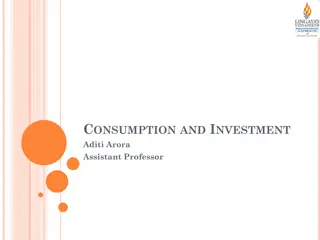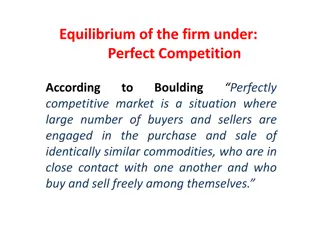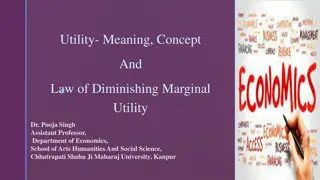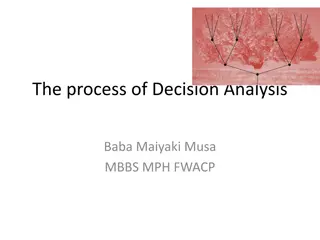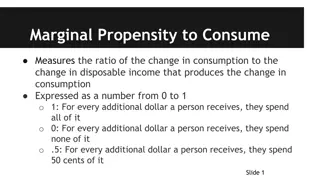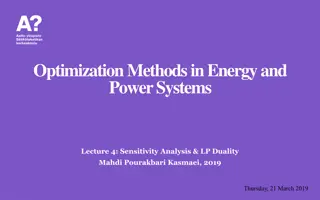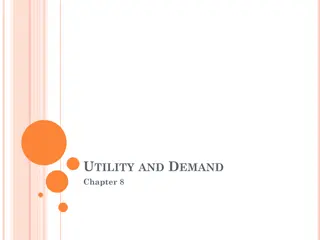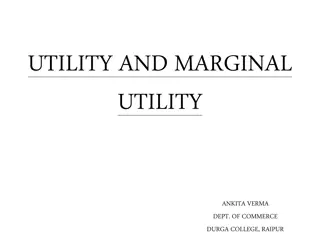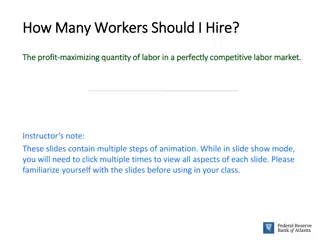Understanding Marginal Analysis in Economic Decision-Making
Marginal analysis involves comparing Marginal Benefit with Marginal Cost to determine the optimal quantity for an activity. If Marginal Benefit is greater than Marginal Cost, there is a Net Marginal Benefit; if it's less, there's a Net Marginal Cost. The principle helps weigh costs and benefits before making economic decisions, whether it's an Either-Or decision like building a library or a school, or a How Much decision like adjusting work hours or college credits. The optimal quantity is where Marginal Benefit equals Marginal Cost or Marginal Benefit is greater than Marginal Cost. Applying marginal analysis aids in making informed economic choices.
Download Presentation

Please find below an Image/Link to download the presentation.
The content on the website is provided AS IS for your information and personal use only. It may not be sold, licensed, or shared on other websites without obtaining consent from the author. Download presentation by click this link. If you encounter any issues during the download, it is possible that the publisher has removed the file from their server.
E N D
Presentation Transcript
MARGINAL ANALYSIS Marginal Cost v. Marginal Benefit
TODAYS OBJECTIVE After today s lesson, students will be able to Understand and distinguish between the two types of economic decisions Either-Or and How Much decisions Understand the method of economic decision making Weighing the costs and benefits of any activity before undertaking that activity Essential Skill: Demonstrate understanding of concepts
EITHER-OR OR HOW MUCH The state government is considering whether to build a public library or a new elementary school. Either-Or Decision Executives at Apple Computer are debating whether or not to produce an additional 300,000 IPhones this year How Much Decision You have been accepted into the Peace Corp and will be posted to the Czech Republic. You must now decide whether to join the Peace Corp or to go to school full time at the University of Florida Either-Or Decision You are deciding whether to cut back your 30-hour work week to 20 hours so that you can take an evening class at your local college. How Much Decision The price of tuition at your community college has gone up. You re considering taking less credits. How Much Decision
MARGIN The margin is defined as the next step It could be an incremental step (a little bit more) or a detrimental step (a little bit less) The principle of marginal analysis is use to answer the how much question.
MARGINAL ANALYSIS INVOLVES COMPARING The benefit from the next step which is called Marginal Benefit WITH The cost of taking the next step which is called the Marginal Cost
MARGINAL ANALYSIS If Marginal Benefit > Marginal Cost The activity yields a Net Marginal Benefit If Marginal Benefit < Marginal Cost The activity yields a Net Marginal Cost If Marginal Benefit = Marginal Cost You have reached the optimal quantity
THE RULE OF MARGINAL ANALYSIS The optimal quantity is the quantity at which: Marginal Benefit = Marginal Cost or Marginal Benefit > Marginal Cost
APPLYING MARGINAL ANALYSIS Example 1: Jerry owns a candy store. The store's revenues depend on the number of hours the store is open each day as shown in the Table below. The cost of staying open each hour is $10. If Jerry follows the marginal principle, how many hours each day should he keep his store open? Hours Open Total Revenue (Total Benefit) $ 0 0 1 25 2 45 3 60 4 70 5 75 6 79 7 81 8
Solving the problem Step 1: Determine what is the marginal benefit? The marginal benefit is the marginal revenue or incremental revenue. Marginal Benefit ( Total Benefit) $ Hours Open Total Revenue (Total Benefit) $ 0 0 0 25 1 25 20 2 45 15 3 60 10 4 70 5 5 75 4 6 79 3 7 81 9 9
Step 2: What is the marginal cost? The marginal cost is what Jerry has to pay to keep the store open for each additional hour. Marginal Benefit ( Total Benefit) $ Marginal Cost $ Hours Open Total Revenue (Total Benefit) $ 0 0 0 $0 25 10 1 25 20 10 2 45 15 10 3 60 10 10 4 70 5 10 5 75 4 10 6 79 3 10 7 81 10 10
Step 3:Compare the marginal benefit and the marginal cost for each hour that the store is open to determine if Jerry should keep it open. Marginal Benefit ( Total Benefit) $ Hours Open Total Revenue (Total Benefit) $ Marginal Cost $ Net Marginal Benefit/Cost $ 0 $0 $0 0 0 1 25 25 10 25-10 = 15 2 45 20 10 20-10= 10 3 60 15 10 5 4 70 10 10 0 5 75 5 10 5 6 79 4 10 6 7 81 3 10 7 11 11
The optimal number of hours is 4. For the 4th hour, marginal benefit equals marginal cost. Marginal Benefit ( Total Benefit) $ Hours Open Total Revenue (Total Benefit) $ Marginal Cost $ Net Marginal Benefit/Cost $ 0 0 0 0 0 1 25 25 10 25-10 = 15 2 45 20 10 20-10= 10 3 60 15 10 5 4 70 10 10 0 5 75 5 10 5 6 79 4 10 6 7 81 3 10 7 12 12
CLEANING YOUR ROOM Your room is dirty Let s clean it. How clean? What are the benefits of different degrees of clean? What is the marginal opportunity cost?
HOW MUCH OF A PARTICULAR ACTIVITY? Pursue activities as long as the marginal benefit exceeds the marginal opportunity cost Pursue activities up to the point where: MB = MOC If the marginal benefit of another unit of the activity is greater than the marginal opportunity cost, go for it! If the marginal benefit of another unit of the activity is less than the marginal opportunity cost, stop!





